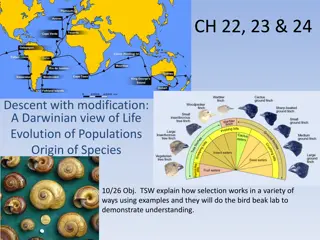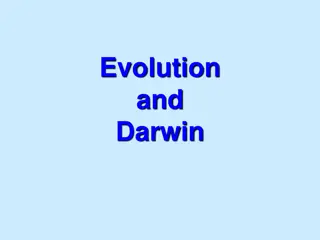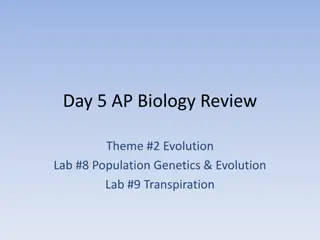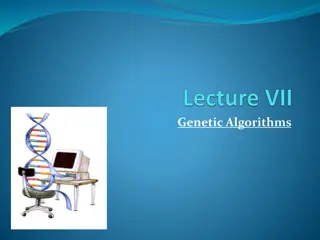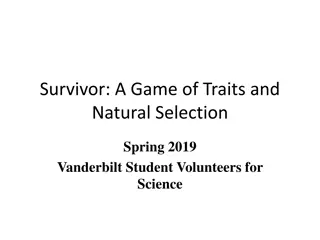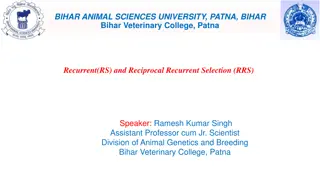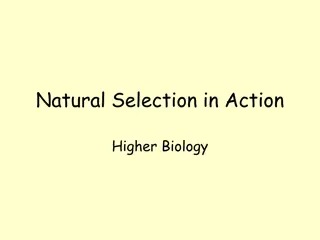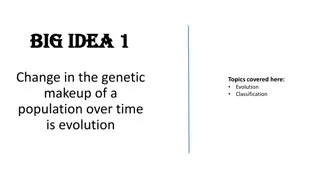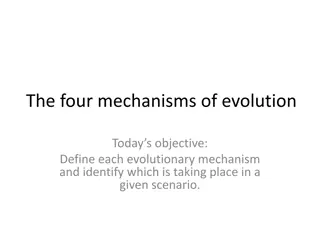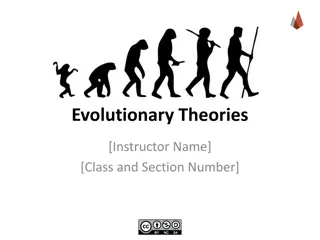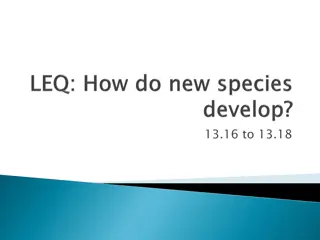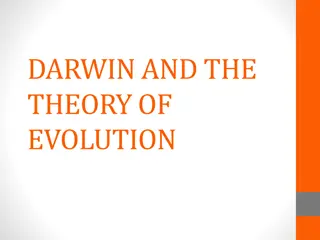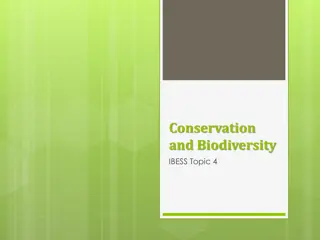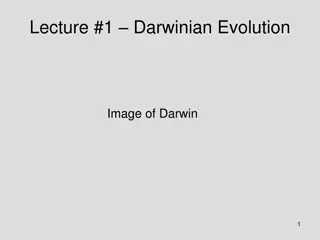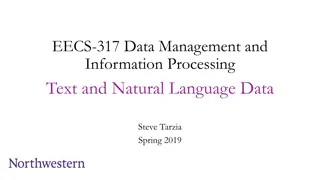Understanding Evolution by Natural Selection
Explore the concepts of species, mutation, Darwin's theory of evolution, and the role of genetic variation through mutations. Learn how mutations can lead to rapid changes in species and why a wider variety of genes in a gene pool benefits a population. Delve into the effects of mutations on individuals and populations, and understand the difference between genotype and phenotype. Discover the impact of inherited and environmental factors on characteristics and the significance of Darwin's observations on natural selection during his voyage.
Download Presentation

Please find below an Image/Link to download the presentation.
The content on the website is provided AS IS for your information and personal use only. It may not be sold, licensed, or shared on other websites without obtaining consent from the author. Download presentation by click this link. If you encounter any issues during the download, it is possible that the publisher has removed the file from their server.
E N D
Presentation Transcript
Evolution by natural selection Progress indicators Good progress: Define the terms species and mutation Describe Darwin s theory of evolution by natural selection. Outstanding progress: Explain why mutation may lead to more rapid change in a species. Do now activity: 1. Identify some examples of characteristics which are caused by inherited and environmental factors. 2. What is a mutation? 3. Why is it beneficial for there to be a wider variety of genes within a gene pool of a population? Explain your answer.
Mutation and genetic variation Mutations can arise through meiosis and sexual reproduction, this results to changes in the DNA code. These variations in DNA can give rise to various characteristics. Many mutations have little effect on the phenotype of an organism. However, in some cases a mutation can have a devastating effect on the health of an organism, sometimes the organism may not survive. Very rarely a mutation gives rise to a trait which make an organism better suited to its environment or gives it an advantage if there is an environmental change. Q1. What is the difference between a genotype and a phenotype? Q2. Through which processes can mutations arise Q3. Describe the potential effects a mutation can have on a population of organisms.
Self-assessment: 1. A genotype describes the alleles present in an individual, with regards to a particular characteristic. Whereas a phenotype describes the physical appearance of an individual, with regards to a particular characteristics. 2. Mutations can arise through the process of meiosis (crossing over and independent assortment) and sexual reproduction. 3. Mutations can have little or no effect on a population as it causes no changes to their phenotype. If a mutation leads to a genotype which disrupts the synthesis of a particularly important protein this can harm the health of an individual and it may causes the population numbers to go down. Occasionally a mutation can lead to a phenotype which is advantageous for an individual, if the environment changes the organism now has a trait which may help it to survive.
Task: Watch the video and answer the following questions: 1. Where did Darwin sail to in 1835? 2. What are the names of some of the organisms which Darwin studied from this island? 3. What did Darwin and Gould conclude about the fiches found on the islands? 4. How did the finches differ from each other? 5. How did Darwin explain these variations? 6. What was Darwin s theory of natural selection? https://www.youtube.com/watch?v=s64Y8sVYfFY
Self-assessment: 1. 2. Darwin studied finches, giant tortoises and marine iguanas 3. Darwin and Gould concluded that the birds were all similar to a mainland finch suggesting the mainland species once colonised the islands. 4. However, the finches showed differences compared to the mainland finch and to each other, variations such as beak size, claw size and overall shape. 5. Darwin believed these differences were due to the difference food sources available on the island 6. Darwin s theory of natural selection stated that the variations seen between the finches arose by chance. Those characteristics which gave the organism an advantage meant the organism was more likely to survive and therefore reproduce, thus outcompeting those without the trait. Darwin sailed to the Galapagos Islands
Survival of the fittest Individual organisms within a particular species may show a wide range of phenotype and genetic variation. Individuals with characteristics most suited to the environment are more likely to survive and breed. The alleles that have enabled these individuals to survive are then passed on to the next generation.
Task: Complete the cartoon strip, with a diagram of an organism of choice (or a made up one!) to demonstrate the process of natural selection: Key Words: characteristics, alleles, variation, species, breed, survive, phenotype, generation, environment Individuals with __________ better suited to the _________ are more likely to survive and _______ successfully. Individual organisms within a particular _______ may show a wide range of ________ and genetic _______. The _______ that have enabled these individuals to _______ are then passed on to the next ________.
Self-assessment: Individual organisms within a particular species may show a wide range of phenotype and genetic variation. Individuals with alleles better suited to the environment are more likely to survive and breed successfully. The characteristics that have enabled these individuals to survive are then passed on to the next generation.
Headlice are now more resistant to insecticides such as permethrin and malathion. That is our fault. We changed the environment and those lice that happened to have an allele that conferred resistance to these insecticides lived and passed on this now advantageous allele to its offspring Task: Sort the cards into the correct order to describe the evolution of headlice by natural selection.
B There is a lot of genetic variation in the head louse population as there is a large number of alleles Head lice and natural selection A The few remaining head lice survive because they happen to have alleles which them resistant to the chemicals C The head lice that survive breed and produce offspring which inherit the alleles that make them resistant to the chemical D Over centuries many different mutations have produced different alleles E Soon virtually all of the head lice are resistant to the chemicals F The alleles for resistance to the chemical become more common in the population G Now when people use the shampoo it does not kill the headlice H Head lice have become a problem again, this is an example of natural selection IHead lice have been infesting peoples heads for millions of years K For a while, all but a few head lice are killed by the chemicals in the shampoo. Head lice are no longer a problem. J Drug companies develop shampoos containing chemicals which kill the head lice
Check your work: Head lice and natural selection I J B D K A C F H G E
Task: Exam question (5 marks) Two different species of butterfly: Amauris Hypolimnas Both species can be eaten by most birds. Amauris has a foul taste which birds do not like, so birds have learned not to prey on it. Hypolimnas does not have a foul taste but most birds do not prey on it. Describe, in terms of natural selection, how Hypolimnas may have developed its wing markings
Self-assessment: Mutation caused changes in marks in Hypolimnas. Competition; less predation of butterflies with these markings. These butterflies survived to reproduce; other butterflies were eaten. Advantageous allele/gene was passed on to offspring. Over time population of Hypolimnas start to look more like Amauris; evolution
Plenary ~ If these are the answers, what could the question be? 1. Natural selection 2. Allele 3. Environmental change 4. Phenotype 5. Charles Darwin
A The few remaining head lice survive because they happen to have alleles which them resistant to the chemicals A The few remaining head lice survive because they happen to have alleles which them resistant to the chemicals B There is a lot of genetic variation in the head louse population as there is a large number of alleles B There is a lot of genetic variation in the head louse population as there is a large number of alleles C The head lice that survive breed and produce offspring which inherit the alleles that make them resistant to the chemical C The head lice that survive breed and produce offspring which inherit the alleles that make them resistant to the chemical Head lice and natural selection Head lice and natural selection D Over centuries many different mutations have produced different alleles E Soon virtually all of the head lice are resistant to the chemicals D Over centuries many different mutations have produced different alleles E Soon virtually all of the head lice are resistant to the chemicals F The alleles for resistance to the chemical become more common in the population F The alleles for resistance to the chemical become more common in the population G Now when people use the shampoo it does not kill the headlice G Now when people use the shampoo it does not kill the headlice H Head lice have become a problem again, this is an example of natural selection H Head lice have become a problem again, this is an example of natural selection I Head lice have been infesting peoples heads for millions of years I Head lice have been infesting peoples heads for millions of years K For a while, all but a few head lice are killed by the chemicals in the shampoo. Head lice are no longer a problem. K For a while, all but a few head lice are killed by the chemicals in the shampoo. Head lice are no longer a problem. J Drug companies develop shampoos containing chemicals which kill the head lice J Drug companies develop shampoos containing chemicals which kill the head lice






